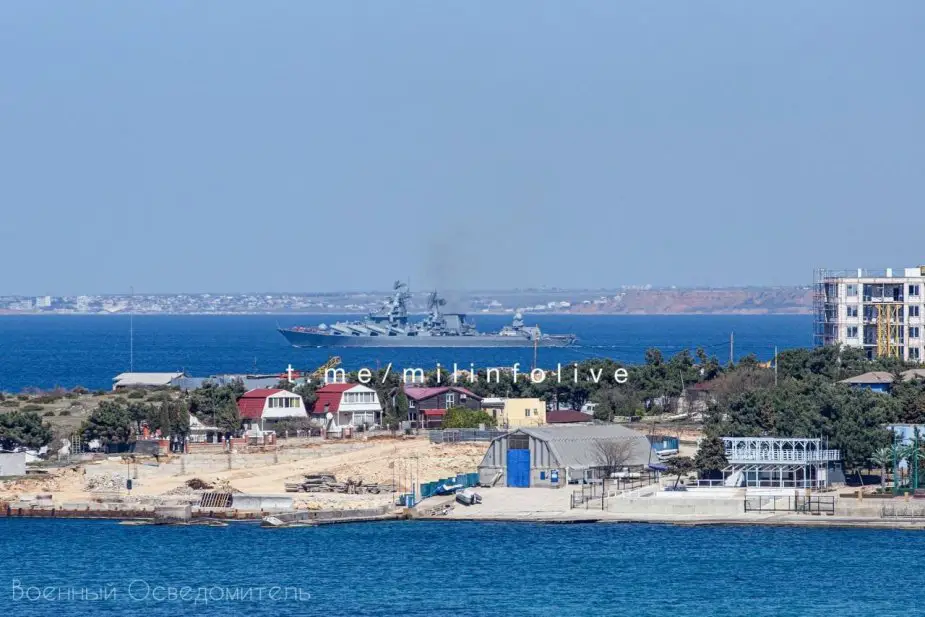Breaking news
Technical review about the sunked Russian Slava-class cruiser Moskva.
According to information published by Tass on April 15, 2022, the Moskva missile cruiser sank while being towed amid a storm because of hull damage sustained during the detonation of ammunition.
Follow Navy Recognition on Google News at this link
 Last departure of the Russian Slava class cruiser Moskva on April 10, 2022, Sebastopol (Picture source: Военный Осведомитель)
Last departure of the Russian Slava class cruiser Moskva on April 10, 2022, Sebastopol (Picture source: Военный Осведомитель)
Ukrainian forces said they hit the Russian cruiser Moskva with their R-360 Neptune anti-ship cruise missiles, fired from Odessa. Other sources speak of the Turkish-made Bayraktar TB2 Unmanned Aerial Vehicle that was used as a diversion.
Moskva, formerly Slava, was a guided-missile cruiser of the Russian Navy. She was the lead ship of the Project 1164 Atlant class and was named after the city of Moscow.
She was the flagship of the Russian Black Sea Fleet and helped lead the naval assault during the 2022 Russian invasion of Ukraine. With a crew of 510, she was the most powerful surface vessel in the region.
About Project 1164 Atlant or Slava-class
The Project 1164 "Atlant" class of missile cruisers was first laid in 1976 and was intended to be a smaller alternative to the "Ushakov-class" heavy nuclear-powered missile cruisers - possibly as the prime escort vessel for the large aviation cruisers.
The first ship of this class was launched in 1979 at shipyard no 445 "61 Kommunara" at the city of Nikolayev in Ukraine and was commissioned in 1983 under the name 126 "Slava" - providing NATO with the class designation "Slava-class".
When the ship was called in for a much-needed overhaul, the city of Moscow "adopted" it and paid the costs of the overhaul - in this connection, the ship was renamed "Moskva" and the NATO class designation was subsequently changed to "Moskva-class". The "Moskva" was finally re-commissioned with hull number "121" after its overhaul in 2000.
The Pr 1164 Atlant or "Moskva-class" is of a much lighter design as compared to the Pr 1144/ "Kirov class" (less than half the displacement; 11.500 tons against 24.300 tons).
The armament of the "Moscow-class" is not as divers as that of the "Kirov class" - it is primarily equipped for anti-surface and anti-air warfare, with only minimal ASW capabilities for self-defense.
Nevertheless, the "Moskva-class" is far from being "weak" in terms of armament - as the main armament deploying 16 Chelomey P-500 Bazalt(4K80)/SS-N-12 "Sandbox" long-ranged surface to surface missiles carried in 4 twin launchers on either side of the ship. The P-500 missile is 11.7 m long and weighs 4600 kg and is a supersonic anti-ship cruise missile with a 500 kg HE warhead and a range of app. 500 km.
2 x 130mm/70 cal AK-130 main guns in one twin mount(front). The AK-130 has a range of over 22 km and a maximum rate of fire of 35 rounds per minute.
It has a computer-controlled system with a multi-band radar, television, optical target sighting, and gun mounts with a turret-mounted Kondensor optical sighting unit. The gun can be operated manually or in the fully automatic mode via a remote control interface to the radar control system.
All 4 units are equipped with the MR-800 Voshkod long-range air search radar - in addition, the first two units, the "Moskva" and the "Marshal Ustinov", have the MR-700 Fregat air/surface search radar, while the last two units, the "Varyag" and the "Lobov"(now "Ukraina"), have this replaced with the later MR-710 Fregat-MA - recognizable by the distinct slightly "tilted" opposing panels often occupying the top of radar masts onboard most modern Russian navy vessels.





























